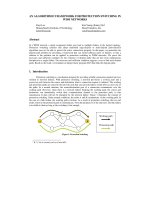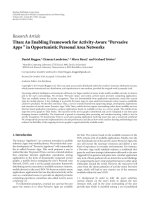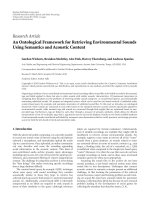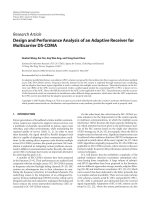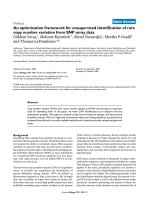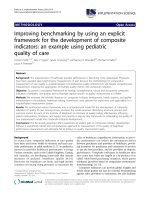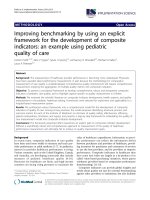An adaptive framework for end to end quality of service management
Bạn đang xem bản rút gọn của tài liệu. Xem và tải ngay bản đầy đủ của tài liệu tại đây (1.65 MB, 200 trang )
AN ADAPTIVE FRAMEWORK FOR END-TO-END
QUALITY OF SERVICE MANAGEMENT
LIFENG ZHOU
(B.S. and M. Eng., Nanjing University)
A THESIS SUBMITTED
FOR THE DEGREE OF DOCTOR OF PHILOSOPHY
DEPARTMENT OF COMPUTER SCIENCE
NATIONAL UNIVERSITY OF SINGAPORE
2008
ii
Acknowledgement
First and foremost, I wish to express my deepest gratitude to my supervisor, Dr. Pung
Hung Keng and co-supervisor Dr. Ngoh Lek Heng for their invaluable guidance and
support throughout my research efforts towards this thesis. Their insights and
suggestions to the problems in this thesis have enlightened me in various detailed
aspects throughout the work.
Dr. Ooi Wei Tsang, Dr. Samarjit Chakraborty and Associate Professor Roger
Zimmermann have served as my reviewers at different stages of this thesis. I would
like to express my appreciation for their suggestions and comments and their time in
reviewing this thesis.
I would like to thank all my colleagues in the Network Systems & Services (NSS)
Laboratory. Among them, special thanks go to Dr. He Jun, Dr. Gu Tao, Dr. Long Fei,
Dr. Chen Lei, Ms. Feng Yuan, Ms. An Liming and Mr. Suthon Sae-Whong for their
constant assistance and encouragements.
Last but not least, I would like to thank my parents and my wife for their love,
unconditional support and patience during the course of my doctoral studies.
iii
Table of Contents
CHAPTER 1 INTRODUCTION 1
1.1 MOTIVATION 3
1.2 PROBLEM STATEMENT 6
1.3 THESIS CONTRIBUTIONS 7
1.4 THESIS OUTLINE 9
CHAPTER 2 LITERATURE REVIEW 10
2.1 QOS IN COMMUNICATION SYSTEMS 11
2.2 QOS PROVISIONING ARCHITECTURES 12
2.2.1 Network QoS Models 12
2.2.2 QoS-aware Operating Systems 14
2.2.3 QoS Middleware 15
2.2.4 Multimedia Applications and Media Framework 19
2.2.5 Cross-layer QoS Architectures 20
2.2.6 End-to-end QoS Schemes 22
2.3 DYNAMIC PROTOCOL COMPOSITION 23
2.4 SUMMARY 25
CHAPTER 3 THE QOS COORDINATION AND MANAGEMENT FRAMEWORK 26
3.1 REFERENCE MODEL FOR QOS MANAGEMENT 26
3.2 QCMF MANAGEMENT ARCHITECTURE 30
3.3 QCMF MANAGEMENT FUNCTIONS 32
3.4 SUMMARY 35
CHAPTER 4 END-TO-END QOS KNOWLEDGE MODELING 36
4.1 QOS KNOWLEDGE AND QOS ONTOLOGY 36
4.1.1 Related Work 36
4.1.2 General QoS Knowledge 38
4.1.3 QoS Ontology and RDFS Schema 40
4.1.4 QoS Ontology Predicates 42
4.2 APPLICATION QOS KNOWLEDGE MODELING 44
4.2.1 Motivation and Design Considerations 44
4.2.2 Two Layer Application QoS Ontology Model 48
4.2.3 QoS Domain Specification and Knowledge Acquisition 50
4.2.4 QoS Compilation and Mapping 55
4.3 MIDDLEWARE QOS KNOWLEDGE MODELING 57
4.3.1 Design Considerations 57
4.3.2 Ontology Modeling of Protocols 61
4.3.3 Semantic Protocol Stack Composition 64
4.4 NETWORK QOS KNOWLEDGE MODELING BRIEFING 67
4.5 QOS KNOWLEDGE PROCESSING 68
4.5.1 Knowledge Sharing 69
4.5.2 Knowledge Reasoning 71
4.6 SUMMARY 75
CHAPTER 5 END-TO-END QOS VIOLATION ANALYSIS 76
5.1 DESIGN CONSIDERATIONS 76
5.2 OVERVIEW OF OUR APPROACH 80
5.3 END-TO-END QOS VIOLATION ANALYSIS 83
5.3.1 End-to-end Monitoring of QoS Violations 83
5.3.2 Application QoS Violation Indicator 84
iv
5.3.3 Correlate Application QoS Violations with Flow Statistics 86
5.4 VIOLATION CLASSIFICATION WITH NEURAL NETWORK 89
5.4.1 Neural Network Algorithms Briefing 90
5.4.2 Offline Algorithms 92
5.4.3 Online Algorithms 92
5.5 SUMMARY 94
CHAPTER 6 CROSS-COMPONENT QOS ADAPTATION 95
6.1 END-TO-END QOS MODEL 95
6.2 NETWORK QOS MODEL 98
6.3 END-HOST QOS MODEL 101
6.4 END-TO-END COORDINATION AND ADAPTATION 103
6.4.1 Information Gathering Algorithm 104
6.4.2 Cross-component Adaptation Evaluation Algorithm 106
6.4.3 End-to-end Signaling and Adaptation Algorithm 113
6.5 SIMULATION RESULTS 114
6.6 SUMMARY 119
CHAPTER 7 IMPLEMENTATION AND EVALUATIONS 121
7.1 IMPLEMENTATION SCENARIO 121
7.2 QOS KNOWLEDGE PROCESSING 123
7.2.1 SQS Initiation Delay 124
7.2.2 Knowledge Reasoning Performance 125
7.3 QOS VIOLATION ANALYSIS 127
7.3.1 Testing Cases 129
7.3.2 Data Analysis 134
7.4 END-TO-END QOS MANAGEMENT 140
7.4.1 QCMF Management Procedures 140
7.4.2 QCMF Management Performance 144
7.4.3 Control Channel Overhead 149
7.5 SUMMARY 151
CHAPTER 8 CONCLUSIONS AND FUTURE WORK 152
8.1 THESIS SUMMARY 152
8.2 FUTURE WORK 155
APPENDIX A ORTHONORMAL NETWORK FOR CLASSIFICATION 158
A. SINGLE HIDDEN LAYER FEEDFORWARD NETWORK WITH RANDOM HIDDEN NODES 158
B. APPROXIMATION WITH ORTHONORMAL BASIS 160
C. GRAM-SCHMIDT ORTHONORMALIZATION 162
D. SUMMARY OF ORTHONORMAL TRANSFORMATION 164
APPENDIX B AN EXAMPLE ONTOLOGY FOR PROTOCOLS 166
A. PROTOCOL.RDF 166
B. INSTANCE.RDF 167
BIBLOGRAPHY………………………………………………………………………………… …170
v
List of Tables
TABLE 4-1: QOS PROFILES FOR MOBILE MULTIMEDIA APPLICATIONS 53
TABLE 4-2: PARTIAL RDFS REASONING RULE SET IN QCMF 72
TABLE 4-3: EXAMPLE FIRST-ORDER LOGIC RULES FOR COORDINATED QOS ADAPTATION 74
TABLE 5-1: TUNABLE PARAMETERS IN VIDEO TRANSMISSION, APPLICATIONS 84
TABLE 5-2: FLOW DESCRIPTORS FOR END-TO-END QOS 86
TABLE 6-1: SERVICE OPTIONS TABLE OF A NETWORK QOS COMPONENT 98
TABLE 6-2: SERVICE STATUS TABLE OF A NETWORK QOS COMPONENT AS IS MAINTAINED BY QMAN
MIDDLEWARE INSIDE THE FLOW RECEIVER
; FOR EACH NETWORK QOS COMPONENT, A
CORRESPONDING TABLE IS KEPT BY
QMAN AND UPDATED THROUGH EITHER PUSH OR PULL MODE
103
TABLE 6-3: SERVICE SUBSCRIPTION SETTINGS OF A FLOW IN SIMULATION AND THE ITS UTILITY FACTOR
114
TABLE 7-1: TESTBED CONFIGURATIONS 123
TABLE 7-2: QOS VIOLATION CLASSIFICATION IN VIEW OF CONTROLLABLE RESOURCES AND AVAILABLE
END
-TO-END ADAPTATION CHOICES 128
TABLE 7-3: QOS VIOLATION TEST WITH PLANETLAB NODES (SOURCE FROM NUS) 134
TABLE 7-4: SPECIFICATION OF QOS VIOLATION DATASETS: THE WIRED-LINE CATEGORY CONTAINS DATA
OBTAINED FROM TESTBED
, CAMPUS NETWORK AND PLANETLAB PLATFORM 134
TABLE 7-5: CLASSIFICATION ACCURACY OF QOS VIOLATIONS IN DIFFERENT ALGORITHMS 135
TABLE 7-6: CLASSIFICATION ACCURACY FOR QOS VIOLATIONS IN OUR ORTHONORMAL ALGORITHM 138
TABLE 7-7: USER-DEFINED ADAPTATION POLICIES FOR VIDEO STREAMING 144
TABLE 7-8: TIME TAKEN IN END-TO-END QOS MANAGEMENT 145
vi
List of Figures
FIGURE 3-1: REFERENCE MODEL FOR END-TO-END QOS PROVISIONING AND COORDINATION 26
FIGURE 3-2: END-TO-END QOS TRANSMISSION SCENARIO 30
FIGURE 3-3: QCMF INCORPORATES BOTH HOST ARCHITECTURES AND NETWORK ARCHITECTURES 31
FIGURE 3-4: QCMF DESIGN CONCEPTS: CONTROL PLANE FOR SIGNALING, DATA PLANE FOR MEDIA
TRANSMISSION AND KNOWLEDGE PLANE FOR META
-DATA RECORDING 32
FIGURE 3-5: MANAGEMENT FUNCTIONS OF QCMF ARE FULFILLED BY ITS SEVERAL BUILD-TIME AND
RUNTIME EXECUTION MODULES
: SEMANTIC QOS SPECIFICATION (SQS) FOR KNOWLEDGE
MODELING
, MIDDLEWARE QOS MANAGER (QMAN) FOR RUNTIME MANAGEMENT AND DYNAMIC
PROTOCOL FRAMEWORK (DPF) FOR MIDDLEWARE LEVEL ADAPTATION 35
FIGURE 4-1: PARTIAL QOS ONTOLOGY FOR ACCESS NETWORK WRITTEN IN RDFS 43
FIGURE 4-2: SEMANTIC MODELING AND SYNTACTICAL QOS SPECIFICATION IN QCMF 47
FIGURE 4-3: THE HIERARCHICAL APPLICATION QOS ONTOLOGY MODEL 48
FIGURE 4-4: PARTIAL QOS DOMAIN SPECIFICATION FOR VIDEO STREAMING APPLICATIONS 51
FIGURE 4-5: AN EXAMPLE OF KNOWLEDGE BUILT IN THE VIDEO-AUDITORY QOS DOMAIN 52
FIGURE 4-6: DYNAMIC COMPILATION OF AQOSPEC 55
FIGURE 4-7: ARCHITECTURE OF DPF WITH ONTOLOGY MODELING 61
FIGURE 4-8: PROTOCOL KNOWLEDGE MODELING ENTRY POINT: SERVICE AND CATEGORY CLASSES 62
FIGURE 4-9: TCP IS OF (RDF:) TYPE TRANSPORT AND BELONGS TO TRANSPORT CATEGORY 63
FIGURE 4-10: SEMANTIC PROTOCOL SELECTION AND PROTOCOL STACK BUILDING 65
FIGURE 4-11: RDFS DEFINITION FOR COMPATIBILITY AND DEPENDENCY 66
FIGURE 4-12: END-TO-END QOS KNOWLEDGE SHARING AND ADAPTATION SIGNALING 69
FIGURE 4-13: ONTOLOGY DEFINITIONS FOR SOME OS TYPES AND INSTANCES INFORMATION 73
FIGURE 5-1: OBSERVED JITTER VARIATION IN A VIDEO TRANSMISSION 79
FIGURE 5-2: SINGLE HIDDEN LAYER FEEDFORWARD NEURAL NETWORKS 90
FIGURE 6-1: ABSTRACTED END-TO-END QOS PROVISIONING MODEL 95
FIGURE 6-2: END-HOST QOS MANAGEMENT MODEL (QMAN) 101
FIGURE 6-3: SKELETON OF THE CROSS-COMPONENT ADAPTATION EVALUATION ALGORITHM 107
FIGURE 6-4: DELAY CHANGE AT NETWORK QOS COMPONENT 2 WHERE A VIOLATION HAPPENS AND
COMPONENT
4 WHICH PARTICIPATES IN THE END-TO-END COLLABORATION TO SOLVE THE
VIOLATION
118
FIGURE 6-5: EXPERIENCED END-TO-END DELAY BEFORE/AFTER A DELAY VIOLATION 119
FIGURE 6-6: DELAY OVERHEAD OF ADAPTATION ALGORITHMS AEA AND ASU FOR MESSAGE EXCHANGE
AND SIGNALING AMONG NETWORK
QOS COMPONENTS AND END-HOSTS 119
FIGURE 7-1: TESTBED ENVIRONMENTS 122
vii
FIGURE 7-2: OVERHEAD OF THE TWO-LAYER ONTOLOGY DESIGN 124
FIGURE 7-3: THE ONTOLOGY REASONING PERFORMANCE 126
FIGURE 7-4: KNOWLEDGE REASONING PERFORMANCE COMPARISON 127
FIGURE 7-5: CPU OCCUPIER PROGRAM FOR CPU VIOLATION AT END-HOSTS 128
FIGURE 7-6: OBSERVATION OF END-TO-END QOS W/ AND W/O CPU CONTENTION 130
FIGURE 7-7: TRAFFIC GENERATOR CAN PRODUCE TRAFFIC OF EITHER CONSTANT RATE OR NORMAL
DISTRIBUTION
131
FIGURE 7-8: OBSERVATION OF END-TO-END QOS W/ AND W/O NETWORK CONGESTION 131
FIGURE 7-9: OBSERVATION OF END-TO-END QOS VARIATION IN WIRELESS COMMUNICATION 133
FIGURE 7-10: TESTING CLASSIFICATION ACCURACY COMPARISON BETWEEN LMBP AND ELM 137
FIGURE 7-11: TRAINING TIME COMPARISON BETWEEN LMBP AND ELM 137
FIGURE 7-12: PERFORMANCE OF THE PROPOSED ORTHONORMAL ALGORITHM IN QOS VIOLATION
CLASSIFICATION
: (A) TRAINING AND TESTING ACCURACY CURVES, (B) TRAINING TIME CURVE 138
FIGURE 7-13: AN EXAMPLE QLIST FOR VIDEO STREAMING 140
FIGURE 7-14: GRAPHIC USER INTERFACE (GUI) FOR STREAMING 142
FIGURE 7-15: NETQ PROGRAM FOR DATA PACKET CAPTURING AT THE MEDIA RECEIVER 143
FIGURE 7-16: SAMPLE SPARQL QUERY FOR ONTOLOGY INTEGRITY CHECK BETWEEN TWO INSTANCE
CLASSES
145
FIGURE 7-17: STREAM DELIVERY AND ADAPTATION AT THE MEDIA SENDER 147
FIGURE 7-18: STREAM RECEIPT AND ADAPTATION AT THE MEDIA RECEIVER 147
FIGURE 7-19: QUALITY FLUCTUATION OF THE RECEIVING FRAME RATE BEFORE, DURING AND AFTER
CONGESTION VIOLATION
148
FIGURE 7-20: END-TO-END FLOW STATISTICS OF AN AUDIO STREAMING UNDER VIOLATION 149
FIGURE 7-21: RMI INVOCATION DELAY FOR THE CONTROL PLANE (LOGARITHM SCALE) 150
viii
Summary
High-speed networks and powerful end-hosts enable new types of Quality of Service
(QoS) sensitive applications such as Video-On-Demand to be offered. In contrast to
traditional text and data applications which are burst and elastic in nature, these
emerging real-time multimedia applications are demanding on system resources such
as bandwidth and CPU, and are also sensitive to continuous QoS performance. To
provide end-to-end QoS to users, researchers have spent great efforts in finding
suitable QoS provisioning mechanisms in areas such as QoS middleware, adaptive
applications and QoS-aware networks. We find that the approaches of most existing
researches have been piecemeal, wherein each focusing on a different aspect of the
QoS provisioning mechanisms. We argue that the real design issue of end-to-end QoS
is more complex than when each of these QoS mechanisms is considered on its own. It
is therefore not sufficient to rely merely on, say middleware, applications or networks
to fulfill end-to-end QoS. Instead, an integrated approach to the overall end-to-end
QoS provisioning, harmonizing QoS mechanisms in the applications, middleware and
networks are essential.
In this thesis, we propose an adaptive end-to-end QoS coordination and management
framework (QCMF) for the QoS management of multimedia applications. Unlike other
end-to-end QoS architectures which mainly focus on the interface design between
adjacent layers, resource reservation or work-flow management, QCMF aims at
designing an effective end-to-end QoS platform for accommodating and coordinating
QoS efforts from heterogeneous end-to-end QoS components (e.g., end-host QoS
ix
management and network QoS provision). Our solution encompasses existing or new
QoS mechanisms at three levels: the network level, the middleware level and the
application level, each of which is abstracted as a meta-model in the end-to-end QoS
scenario where their behaviors and interactions are studied. The proposed framework
is adaptive in the sense that it recognizes and coordinates the adaptive behaviors of
multimedia applications and networks in view of the changing runtime environment
context. Besides, QCMF provides the ability of dynamic composition of end-hosts’
communication stacks, which provides another possible dimension of QoS adaptation
at the middleware level.
With the aforementioned methodology in mind, we have proposed a set of techniques
to fulfill our overall design objectives of a coordinated end-to-end QoS management.
Firstly, we propose a unified knowledge plane for end-to-end QoS modeling, in which
QoS information of each end-to-end QoS component is described semantically. The
semantic approach of modeling QoS knowledge facilitates the deployment of
multimedia applications in heterogeneous environments where services of desirable (or
compatible) features can be selected according to runtime service availability.
Moreover, information sharing among QoS components becomes easier as different
end-to-end QoS components would have a common understanding of QoS knowledge
while interacting with each other. Secondly, we propose a novel approach to the
analysis of QoS violations. By monitoring end-to-end flow statistics and application
performance, a QoS violation can be quickly identified with high accuracy. Such an
approach outperforms traditional rule-based violation detection methods which have
seldom undergone a rigorous testing procedure and require clear margins of QoS
parameters in asserting a QoS violation. Lastly, we propose an end-to-end QoS
coordination scheme and algorithms for runtime collaborative end-to-end QoS
x
management. By exchanging QoS information and coordinating adaptation behaviors
among QoS components, a QoS violation can be solved by either a local adjustment at
the QoS component where the violation takes place or being processed by another QoS
component participating in the end-to-end collaboration. Such a decision is made at
end-hosts in a pure end-to-end fashion without violating the end-to-end design
principle of the Internet. Our prototype implementation validates our design
philosophy and demonstrates that QCMF is functional. Performance evaluation results
of the prototype show that QCMF works effectively in many aspects of end-to-end
QoS management such as control signaling, knowledge processing, violation detection
and coordinated adaptation.
xi
Publications
[1] Lifeng Zhou, Lei Chen, Hung Keng Pung and Lek Heng Ngoh, “Identify QoS
Violations through Statistical End-to-end Analysis”, to submit to a journal, 2009
[2] Lei Chen, Lifeng Zhou and Hung Keng Pung, “Universal Approximation and
QoS Violation Applications of Extreme Learning Machine”, accepted by Neural
Processing Letters, Springer, 2008
[3] Lei Chen, Lifeng Zhou and Hung Keng Pung, “Universal Approximation
Analysis and Applications of Orthonormal Neural Networks”, submitted to
International Journal of Pattern Recognition and Artificial Intelligence, 2008
[4] Lifeng Zhou, Lei Chen, Hung Keng Pung and Lek Heng Ngoh, "End-to-end
Diagnosis of QoS Violations using Neural Networks", in Proc. the 33rd IEEE
International Conference on Local Computer Networks (LCN), 2008
[5] Lifeng Zhou, Hung Keng Pung and Lek Heng Ngoh, “An end-to-end Framework
for Coordinated QoS Adaptation”, in Proc. the 33rd IEEE International
Conference on Local Computer Networks (LCN), 2008
[6] Lei Chen, Lifeng Zhou and Hung Keng Pung, “Approximation Capability of
Feedforward Neural Networks with Least Square Solutions”, accept with major
revision by NeuroComputing, 2008
xii
[7] Lifeng Zhou, Hung Keng Pung, Lek Heng Ngoh and Tao Gu, “Ontology
Modeling of a Dynamic Protocol Stack”, in Proc. the 31st IEEE International
Conference on Local Computer Networks (LCN), 2006
[8] Lifeng Zhou, Hung Keng Pung and Lek Heng Ngoh, “Towards Semantic
Modeling for QoS Specification”, in Proc. the 31st IEEE International
Conference on Local Computer Networks (LCN), 2006
[9] Lifeng Zhou, Hung Keng Pung and Lek Heng Ngoh, “Knowledge Modeling for
End-to-End QoS Management”, in Proc. the 1st International Conference on
Communications and Networking in China (ChinaCom), 2006
[10] Liming An, Hung Keng Pung and Lifeng Zhou, “Design and Implementation of
a Dynamic Protocol Framework”, Computer Communications, Volume 29, Issue
9, pp. 1309-1315, May 2006
[11] Suthon Sae-whong, Hung Keng Pung and Lifeng Zhou, “QMan: an Adaptive
End-to-End QoS Architecture”, in Proc. the 12th IEEE International Conference
on Networks (ICON), 2004
1
Chapter 1 Introduction
CHAPTER
INTRODUCTION
1
1
Most conventional and legacy network applications have been designed to operate in
low to moderate speed (a few 10s of Mbps) network environments. These networks
have been useful and adequate for supporting text and data applications, including
distributed applications requiring short requests-responses, in which relatively small
amount of bandwidth is needed for each transmission. Moreover, these applications are
rather elastic in nature, i.e., they can tolerate great variations in performance such as
packet delay and throughput rates. In recent years, great advance has been made in
communication technologies where networks that can support data traffic in gigabits
per second on every port (e.g., Gigabit Ethernet) are now available off-the-shelf. As a
result, high-speed networks and powerful end-hosts enable new types of applications
such as Video-on-Demand, multimedia-based collaborative computing and
teleconferencing. In contrast to traditional elastic data applications, these emerging
multimedia applications have different traffic characteristics and are demanding on
system resources such as network bandwidth and CPU time slice. The challenges in
designing such applications generally lie in catering for time dependent (or continuous)
media: audio and video. Besides storage speed, memory size and processing power,
timely delivery of media data over networks is also an essential factor. It requires not
only considerable computing resources, but also ensures that these resources will be
available over a certain period of time. Failure to sustain such provisioning will
generally compromise the presentation quality of continuous media. Thus, the need for
2
transmission quality assurances for these Quality of Service (QoS) sensitive
applications arises naturally.
The question of which suitable mechanisms for the provisioning of QoS has been
asked and possible answers suggested and issues debated. One interesting but trivial
suggestion of solution is through over-provisioning of bandwidth. The motivation of
this thought is that bandwidth, due to increasing availability of fibers and wavelength-
division multiplexing (WDM) technique, is potentially abundant and cheap. We
believe over-provisioning can greatly ease QoS problems but is not a panacea. This is
because of at least three main reasons: (1) not all QoS problems are constrained by
bandwidth, jitter is a classical example; (2) no matter how much bandwidth the
network can provide, new innovative applications is likely to be created in the near
future to consume them [1]; (3) unless there is a common physical transmission
technology (fiber is a potential candidate) for all different network solutions, the vision
of the abundant bandwidth cannot be materialized for a very simple reason: all
networks are to be interconnected in one way or the other and hence those networks of
lower bandwidth will become the QoS bottleneck. Indeed LANs, dial-ups, wireless
LANs, WANs and broadband co-exist and interconnect to form the global Internet.
The use of high-speed core networks has not eliminated QoS problems, as we have
known and experienced today. For example, wireless communication technologies,
including wireless LAN (IEEE802.11b/g), Bluetooth and 3G mobile networks, are
being developed and deployed as common services nowadays, which enables wireless
multimedia streaming to be delivered in light-weighted devices such as handset. As
end-applications are very likely to run over either fixed wired networks or wireless
networks, the overall network environment becomes more dynamic and heterogeneous.
Hence the QoS problems are more difficult to be resolved by relying on a simple
3
mechanism, such as over-provisioning of bandwidth. Suitable QoS mechanisms are
needed in networks and end-hosts to best assure the timely delivery of multimedia data.
1.1 MOTIVATION
For over ten years, researchers have proposed various QoS solutions in either end-
hosts or networks. In QoS provisioning through networks, researches have been
focused on providing suitable QoS models and service disciplines, as well as
appropriate admission control and resource reservation protocols. For example, the
Internet Engineering Task Force (IETF) has defined several standard QoS
architectures such as Integrated Services (IntServ) [2], Differentiated Services
(DiffServ) [3], Constraint-based Routing [4] and Multiprotocol Label Switching
(MPLS) [5]. IntServ and DiffServ are well-known network QoS models, which have
been studied and compared (through simulation, prototyping and performance
measurements) by many researchers. IntServ, relying on the Resource Reservation
Protocol (RSVP) [6], duels with resource allocations and reservations for each data
flow and hence would have the potential to provide guaranteed QoS service. Many
network vendors, such as Cisco and Sun Microsystems have IntServ/RSVP
implementations on their routers [7]. On the other hand, DiffServ is based on a simple
model where traffic entering a network is aggregated into classes and treated
differently within a DiffServ-enabled network. There are router prototypes and
products actually implementing DiffServ service. MPLS is a forwarding scheme that
has the ability to aggregate traffic flows and hence can provide a basis for both IntServ
and DiffServ QoS support over core networks. Constraint-based routing intends to
address QoS from the routing point of view by establishing an appropriate route
meeting some QoS constraints such as bandwidth or/and delay requirements.
4
In end-hosts, various QoS architectures have been proposed and discussed. According
to their resource management styles, these solutions can be categorized into
reservation-based approaches and adaptation-based approaches [8]. Reservation-
based approaches employ resource reservation and admission control mechanisms
(such as CPU preemption and scheduling) to guarantee the availability of resources
before multimedia data is delivered [9]. The sustaining of transmission quality depends
on the QoS technologies of the underlying platform (e.g., QoS capability of the
operating system and network), in which the data packets are handled. Nevertheless,
because of the following reasons, multimedia transmission cannot rely solely on such
resource allocation and reservation mechanisms.
• QoS degradation in best effort networks is often unavoidable [10], as QoS
assurance provided by the underlying services may vary from time to time.
• The Internet traffic produced by end-users exhibits a dynamic behavior. There
has been no effective QoS reservation mechanism for dueling with the diverse
QoS requirements of applications and the dynamic behavior of the network
traffic.
• QoS guaranteed technologies have yet to be established as common services,
hence most today’s networks are still operating in best-effort or best assured
mode.
In view of the above restrictions, QoS adaptation, which allows a multimedia
application to react suitably to occurring QoS violations, is essential to ensure that the
application can sustain certain level of QoS in various runtime environments. An
adaptation-based QoS approach can operate in best-effort or QoS-enabled network
environments and manages QoS in a pure end-to-end fashion where QoS monitoring,
analysis and adaptation are enforced throughout the lifecycle of the transmission to
5
smooth the quality fluctuation and best maintain the agreed QoS level. An adaptation-
based approach requires minimum modification to existing network architecture, thus
makes itself more suitable to be deployed over current non-real-time OS and best-
effort network environments (or future QoS-enabled network environments).
In adaptation-based QoS researches, progresses have been made in several directions
such as QoS-aware applications, QoS middleware or QoS-enabled operating systems.
Most work done in the application layer is related to the transmission of continuous
media streams (e.g. variable bit rate codec, media compression, frame-dropping and
layered encoding scheme), and hence is rather media specific and restrictive in certain
application domains [11][12][13][14][15]. On the other hand, researchers have also
proposed research prototypes of QoS enabled/sensitive operating systems, applying
results from real-time scheduling theory to support system level QoS management
[16][17][18]. However, such an approach would often result in a proprietary OS,
which is therefore not popular. In recognition of these limitations, more active research
efforts have been devoted to provide QoS supports as middleware services
[19][20][21][22][23][24]. The QoS middleware approach is popular for at least two
main reasons despite of its performance overhead: (1) the QoS solutions are likely to
be independent of the network and OS platforms, and (2) the QoS controls can be
specifically designed and possibly be transparent to applications.
This thesis proposes an adaptive end-to-end QoS Coordination and Management
Framework (which we call QCMF) for QoS management of end-to-end multimedia
transmission. Different from most existing work that focuses on a particular QoS
provisioning domain (e.g., networks or applications), QCMF provides an integrated
solution for end-to-end QoS management which designs a set of techniques to embrace
6
existing or new QoS efforts from different areas of end-to-end provisioning. Details of
our approach will be discussed later.
1.2 PROBLEM STATEMENT
The need to provide QoS support for networked multimedia applications has long been
recognized and discussed. As QoS issue has not been part of the design considerations
of virtually all network architectures, including that of the Internet, the design and
development of suitable QoS provisioning mechanisms has to be carefully considered
so as to ensure the stability of current Internet architecture and its compatibility with
other add-on network services such as Network Address Translation (NAT) [27]. In
fact, the complexity of QoS provisioning has already resulted in various QoS solutions
each focusing on a different aspect of the QoS provisioning mechanisms, depending on
the perspectives and design centric of the designers. As discussed, these solutions can
be broadly classified into three main design viewpoints: QoS-aware applications,
dedicated QoS middleware and network QoS models.
However, the real design issues of QoS provision are far more complex than when
each of these design viewpoints is considered on its own. This is simply because
meeting performance requirements of QoS-sensitive applications is fundamentally an
end-to-end issue. It requires all QoS-enabled facilities along the end-to-end path
working cohesively to achieve the desired end-to-end performance. As most existing
QoS solutions focus on their respective areas while paying little attention to the
interaction with other QoS services on the end-to-end path, QoS can only be sustained
in their local domains, while no satisfactory end-to-end performance can be provided
to end-users. In this sense, we believe that a more holistic approach to the overall end-
7
to-end QoS provisioning, integrating QoS mechanisms in the applications, middleware
and the networks is essential.
An adaptive QoS coordination and management framework (QCMF) has been
developed based on such a design consideration. The framework embraces QoS
services along the provisioning path and provides mechanisms for QoS coordination
and adaptation among them in both build-time instantiation and runtime QoS
management. Different from existing integrated end-to-end architectures which have
typically developed a whole set of new end-to-end QoS mechanisms by themselves
[9][28], QCMF aims at accommodating existing QoS techniques from different
domains and providing a platform for their interaction. For instance, QCMF does not
invent any new signaling protocol for QoS negotiation among end-to-end QoS
components (opposite to [29]), but makes use of any existing protocols capable of
negotiation. Unlike [30] which designs its own network QoS implementation as part of
its end-to-end QoS efforts, QCMF assumes a generic network service differentiation
model for end-to-end collaboration. Such a model can be easily mapped to existing
standard network QoS models such as DiffServ which is built on the same basic QoS
discipline of service differentiation. In this way, QCMF requires minimum
modification of current network architecture and hence has a better chance to be
accepted and implemented as common utility services over the Internet.
1.3 THESIS CONTRIBUTIONS
This thesis proposes an adaptive QCMF framework for QoS management in end-to-
end multimedia transmission. The solution embraces existing and new QoS
mechanisms at three entity levels: networks, middleware and applications. QCMF
provides necessary management functions that include, for example, QoS negotiation,
8
monitoring and adaptation. With runtime adaptation, QCMF enables multimedia
applications to best maintain certain degree of QoS under constrained system and
network resource availability. In summary, this thesis makes the following key
contributions:
1. We propose a new design philosophy with respect to how current communication
architectures of end-hosts and networks could be modified to accommodate end-to-
end QoS services. Rather than designing a new set of QoS mechanisms for each
communication layer so that they can be seamlessly integrated together for end-to-
end QoS provisioning, we propose to unify existing isolated QoS solutions at
different layers so as to fulfill end-to-end QoS requirement. We believe our
solution is easier to be implemented and deployed in current network environment.
2. (As the continuation of point 1) we propose a set of techniques to enable the
collaboration among end-to-end QoS sub-systems. We treat each of the QoS sub-
systems as a meta-component and design an end-to-end framework and methods
for accommodating and supporting interactions and dynamic adaptations among
them. In this context, we are not participating in the performance enhancement of
QoS mechanisms of any individual layer. Instead, our contribution is to provide a
platform for harmonizing and coordinating existing QoS mechanisms in
applications, middleware and networks in the context of overall end-to-end QoS
provisioning.
3. We propose a uniform semantic approach and meta-models to abstract QoS
characteristics of applications, middleware and networks. Each of these meta-
models will provide consistent interfaces so as to facilitate interactions among
adjacent QoS models. Based on such a semantic specification method, we establish
9
a knowledge plane for QoS information exchange among different QoS-
subsystems for the benefit of end-to-end QoS negotiation and management. The
advantages of such an approach lie in a powerful and expressive method for
specification as well as an easy way for information processing, matching and
sharing.
4. We propose a novel end-to-end approach to QoS management with respect to the
diagnosis of QoS violations. By monitoring end-to-end flow statistics and
application performance, a QoS violation can be quickly identified with high
accuracy as we have tested. Such an approach outperforms a traditional rule-based
violation detection method which has seldom undergone a rigorous testing
procedure and requires clear threshold values of QoS parameters in asserting a QoS
violation.
5. We demonstrate the design concepts of points 1-4 and the functionality of the
proposed QCMF framework through prototype implementation. We have
developed a set of software reflection techniques for the implementation of meta-
QoS models for applications, middleware and networks. In addition, decision-
making algorithms, heuristics and policies have been defined for a collaborative
end-to-end QoS management. Through physical measurements of our
implementation, we have shown that QCMF can achieve the aforementioned
features and functionalities with acceptable overhead.
1.4 THESIS OUTLINE
The rest of the thesis is organized as follows.
10
Chapter 2 surveys relevant literatures in areas of end-host QoS research and network
QoS research. We discuss the features and limitations of existing approaches. The
differences between QCMF and previous work are also compared.
Chapter 3 gives an overall picture of QCMF by explaining its design philosophy (i.e.,
design reference model), system architecture and management functionalities.
Chapter 4 elaborates the knowledge modeling in QCMF whereby characteristics of
each QoS sub-system with respect to end-to-end collaboration are semantically
abstracted and processed.
Chapter 5 explains our approach for runtime QoS monitoring and violation analysis.
We also give an overview of the violation identification algorithms we have engaged,
whose performances are compared and discussed in Chapter 7.
Chapter 6 presents the cross-component adaptation scheme in QCMF. Detailed
description about our design assumptions, meta-models for end-to-end QoS
components and coordination algorithms and heuristics are explored. Simulation
models and results are then introduced which has validated the correctness of our
approach.
Chapter 7 describes our prototype implementation and performance measurements of
QCMF.
Chapter 8 concludes the thesis and discusses future work.
Chapter 2 Literature Review
11
CHAPTER
LITERATURE REVIEW
2
2
The open problem of QoS provisioning has been addressed by various research efforts
in the past years. In this chapter, we will review some of the advance in both network
and end-host QoS researches. More comprehensive end-to-end QoS solutions such as
cross-layer architectures and integrated end-to-end QoS systems will also be
introduced and compared. By examining these related researches, we will show the
advantages of our work over previous studies.
2.1 QOS IN COMMUNICATION SYSTEMS
The term QoS is first introduced to describe characteristics of low-level data
transmission in communication systems. With the appearance of distributed
multimedia applications, the meaning of QoS has been re-defined as “the collective
effect of service performance which determines the degree of satisfaction of a user of
the service” [31]. In general, QoS represents a set of quantitative and qualitative
characteristics of a distributed multimedia system that are necessary to achieve the
required functionality and performance of an application. Here functionality and
performance refers to both the proper delivery of media data to a multimedia
application user and the overall user satisfaction [32].
In practice, QoS is often expressed using measurable QoS parameters. A QoS
parameter describes a specific attribute of a communication system or a performance
requirement of a multimedia application. Each QoS parameter can be viewed as a
typed variable with bounded values. An application’s QoS requirements are conveyed
12
in terms of high-level QoS parameters that specify what the application desires. These
QoS parameters are assessed by the underlying communication system to determine
whether application requirements can be met or not.
The underlying system needs resources to promote its service to multimedia
applications. Essentially, there are two kinds of resources relevant to the performance
of a multimedia application: end-host resources and network resources. The former
consists of processing power, memory, data buffer in an end-host and its peripheral
multimedia devices; the latter includes network bandwidth and packet queuing priority.
To manage these resources for applications, two camps of QoS researches have been
established focusing on their respective areas, namely end-host QoS research and
network QoS research.
2.2 QOS PROVISIONING ARCHITECTURES
The open problem of providing end-to-end QoS support has been addressed by various
research efforts in the past years [9][28][32][33]. This section reviews existing QoS
researches applicable to areas such as network QoS, end-host QoS and end-to-end QoS.
2.2.1 Network QoS Models
To support QoS in the Internet, IETF has defined several standard service models and
mechanisms to meet the demand for QoS. The IntServ/RSVP [2][6] architecture
intends to provide end-to-end bandwidth reservation by maintaining per-flow state
information along the path from the flow sender to the receiver. However, the
complexity of per flow operations usually increases as a function of the number of
flows. In addition, it is difficult to maintain the consistency of per flow state in a
distributed network environment. Thus the IntServ model is not scalable to large
13
networks [1]. Such a scalability problem has resulted in the DiffServ approach [3]
where QoS is achieved by a coarse level of service differentiation among a small
number of traffic classes. The main advantage of DiffServ over IntServ is that core
network will only operate on aggregated flows instead of per flow in IntServ. In edge
routers, packets are processed and aggregated on the basis of service classes. However,
the DiffServ solution will become complex when QoS is to be offered over multiple
DiffServ domains. Notably, there is a widely used QoS reference model merging these
technologies. This includes the models combining IntServ in access network and
DiffServ in the backbone network [34]. MPLS [5], on the other hand, is a layer two
forwarding scheme that has the ability to aggregate traffic flows and hence can provide
a basis for both IntServ and DiffServ QoS support over the core network.
Network QoS research in recent years mostly focuses on (1) the functional
improvement of these standard QoS models through techniques such as traffic
engineering [35][36], or (2) discusses the impact of these models on existing
communication facilities such as the performance variation of TCP protocol [37].
Nevertheless, we should note that network QoS models or solutions discussed above
can only deliver end-point to end-point QoS, i.e., from the network egress point of a
flow sender to the ingress point of a flow receiver. However, the main body of QoS
communication lies within both end-hosts and their applications. In another word,
what we want to satisfy is the QoS requirements from multimedia applications, which
is more precisely, application-to-application QoS. The network QoS models by
themselves, can not provide application-to-application QoS. A simple example is that,
the fluent delivery of video frames to an end-user relies on network resources such as
bandwidth and end-host resources such as CPU time slice. While a network QoS may
assure the provision of bandwidth, the successful end-to-end QoS provision still
